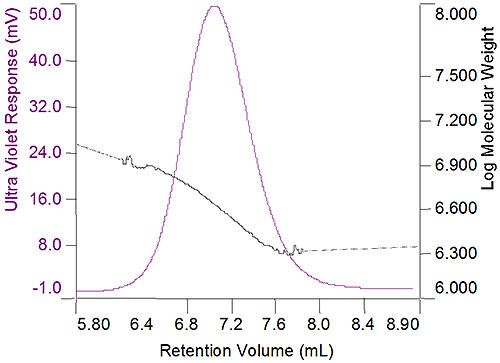Within the biopharmaceutical industry, recombinant plasmid DNAs are used as both raw materials and active ingredients in DNA vaccines. GSK is developing several plasmid DNA vaccines, characterised using different methods. Anion exchange-HPLC (AEC) and agarose-gel-electrophoresis (AGE) are used to determine plasmid topology. Light scattering size techniques are used to provide information on molecular weight. Here we present data, for different DNA plasmids analysed using SEC, LS, RI and V. The TDA detector provides information about the DNA plasmids, including molecular weight, which cannot be analysed using techniques such MS due to the large size of the plasmids.

|

|
The Model 302 TDA was coupled to a Waters Alliance 2690 HPLC. The Waters HPLC UV detector was disconnected, so that the sample flowed from the HPLC into the Model 302 detector. The TDA detectors are connected in series with UV first, LS (90 and 7°), RI then Viscometer.
Analysis of DNA was carried out using a Tosoh Biosep DNA-SEC column. The buffer used to elute the DNA was 25 mM Borate with 0.5M sodium chloride pH 9. The column temperature was set at 40°C, and the flow rate was 0.75 ml/min, with UV detection at 260nm. The injection volume was 100 µl.
The DNA samples were run at a concentration of 10ug loading. The dn/dc value used for the DNA calculations was 0.165.
Calculations were carried out using the UV detector as a concentration detector however, the RI was tested and gave comparable results.
Most plasmid DNA comprises of a mixture of three topoisomers: supercoiled (sc), open circle (oc), and linear (lin).
Supercoiled is the most compact form and is expected to be smaller in size than either linear or open circle forms. There is no appreciable size difference between linear and open circle forms. This trend is consistent for all the plasmid DNA constructs that were run.
|
Sample |
Calculated Mw (MDa) |
Measured Mw(MDa) |
IV (dL/g) |
RH (nm) |
|---|---|---|---|---|
|
DNA-1 sc |
3.86 |
4.16 |
5.3 |
66 |
|
DNA-1 lin |
3.75 |
14.2 |
87 |
|
|
DNA-1 oc |
3.69 |
10.8 |
89 |
|
|
DNA-2 sc |
4.22 |
4.30 |
4.8 |
64 |
|
DNA-2 lin |
4.17 |
14.0 |
89 |
|
|
DNA-2 oc |
4.46 |
12.1 |
91 |
The OmniSEC software is easy to use, and the data is presented in a format that is easy to understand.